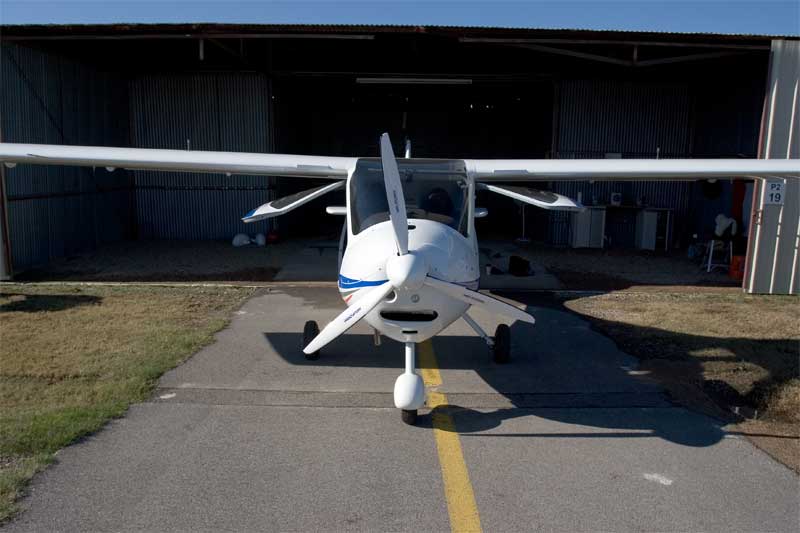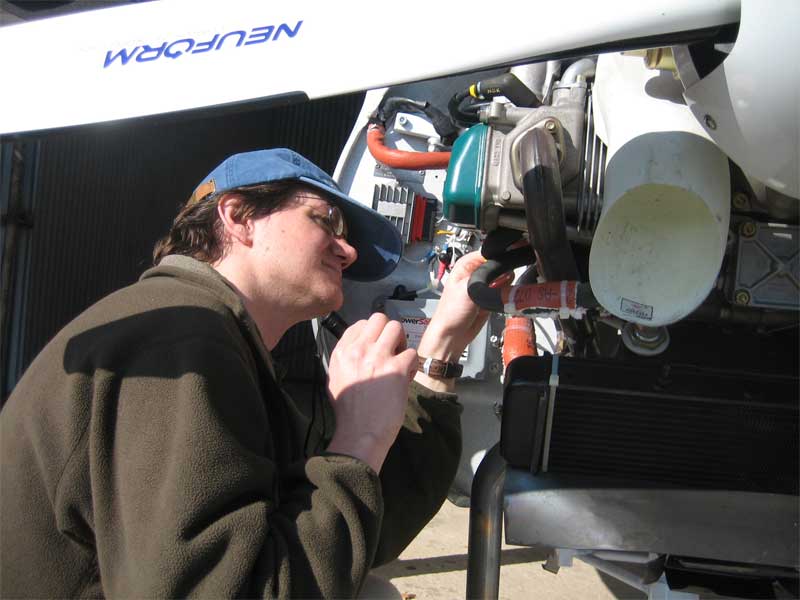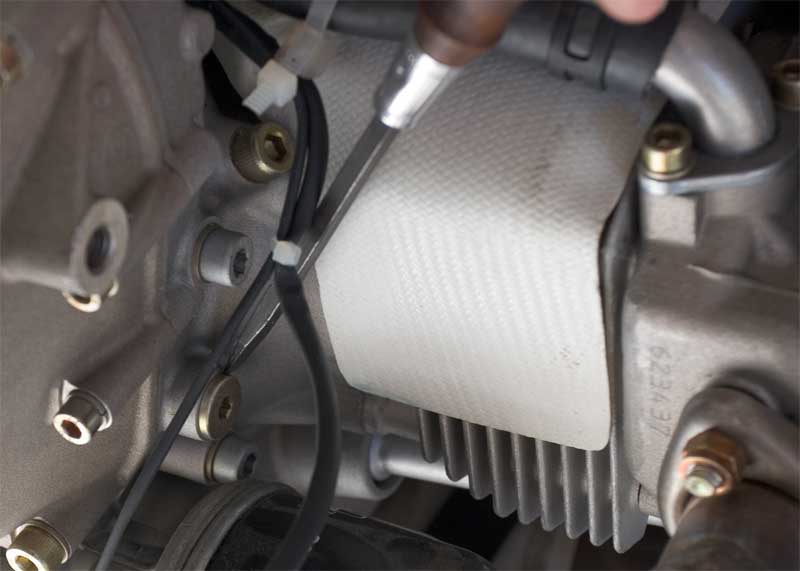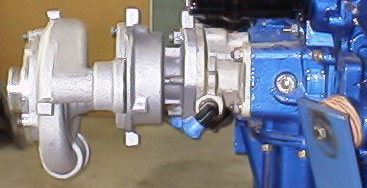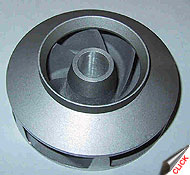Rotary10-RV
Well Known Member
Ok Folks,
Lets be realistic here. First the basic equation Q=h A (delta)T. In the engineering world many factors have already been worked out. Q is the rate of transfer of heat. BTU's/Hr. h is the coefficient of heat transfer. interestingly the transfer from a cast iron surface (turbulent) is 1.0. Aluminum is a but better but for now lets say 1.0. Ok now our equation looks much simpler Q = (1.0) A (delta)T. So let's assume the area is one square foot. The result is greatly simplified. Q= (1.0) (1.0) deltaT. So the rate of transfer is pretty simple. The RATE of exchange is about 2.25 greater for a air cooled engine compared to a water cooled engine. There are many other considerations for a engine but let's keep this as simple as possible. That solution seems pretty obvious, BUT that equation was simplified to the same exact AREA.
Area is the other major adjustable term. h of Water to iron, or better aluminum is 60-80 times greater than to air, so the second needed transfer can practically be discounted in this discussion since the air to radiator rate is going to determine the rate of transfer.
Based on the transfer rate alone, I would say that AC (air cooled) engine has a tremendous advantage. What everyone is ignoring in the equation is A or area. On a air cooled engine the maximum AREA is practically fixed. The heat exchanger (radiator) for a WC (water cooled) engine can be selected based on the heat rejection required. The modern radiator also packages a great deal of area into a given volume. One of the problems manufacturers had with producing cylinders and heads that would hold up on the large AC engines was making enough fin area to dissipate heat at high power and boost. I've got several old War Report findings from Pratt and others that mention the need to carefully machine the fins on the large cylinders to get fine enough pitch for heat rejection. On later versions you will even see a corrigated inserts between fins to increase area and help lessen ringing noise.
What this information shows someone that looks at it rationally is there are advantages and disadvantages to BOTH.
Air Cooled
Advantages: Simpler, high rate of heat rejection, light for a given size.
Disadvantages: Fixed max dissipation, lower specific output for a given size, limited layouts for a high output, IE radial or opposed. high normal operating temperature requires better oils and fuels.
Water Cooled
Advantages: Highest specific output for a given size, freedom of configuration, IE V upright or inverted, radial, opposed, unconventional rotary or barrel engines. heat exchangers can be located remotely and sized for output. Lower normal operating temperature lessens oil and fuel requirements.
Disadvantages: more complex, weight of secondary coolant, weight of remote mounted heat exchangers. Coolant pump is a wear consideration. System must be designed to prevent trapped air. plumbing is more complex and must be protected.
Conclusion: I could make an arguement for either system. The winner in a given situation would depend on the desired characteristics of the engine package. I know this ignores ducting, plenums, and a host of other factors but an arguement can still be made for both types. While I personally like water cooled engines I didn't even put a heater on the list. I will now don my fire suit. Fire away.
Bill Jepson
Lets be realistic here. First the basic equation Q=h A (delta)T. In the engineering world many factors have already been worked out. Q is the rate of transfer of heat. BTU's/Hr. h is the coefficient of heat transfer. interestingly the transfer from a cast iron surface (turbulent) is 1.0. Aluminum is a but better but for now lets say 1.0. Ok now our equation looks much simpler Q = (1.0) A (delta)T. So let's assume the area is one square foot. The result is greatly simplified. Q= (1.0) (1.0) deltaT. So the rate of transfer is pretty simple. The RATE of exchange is about 2.25 greater for a air cooled engine compared to a water cooled engine. There are many other considerations for a engine but let's keep this as simple as possible. That solution seems pretty obvious, BUT that equation was simplified to the same exact AREA.
Area is the other major adjustable term. h of Water to iron, or better aluminum is 60-80 times greater than to air, so the second needed transfer can practically be discounted in this discussion since the air to radiator rate is going to determine the rate of transfer.
Based on the transfer rate alone, I would say that AC (air cooled) engine has a tremendous advantage. What everyone is ignoring in the equation is A or area. On a air cooled engine the maximum AREA is practically fixed. The heat exchanger (radiator) for a WC (water cooled) engine can be selected based on the heat rejection required. The modern radiator also packages a great deal of area into a given volume. One of the problems manufacturers had with producing cylinders and heads that would hold up on the large AC engines was making enough fin area to dissipate heat at high power and boost. I've got several old War Report findings from Pratt and others that mention the need to carefully machine the fins on the large cylinders to get fine enough pitch for heat rejection. On later versions you will even see a corrigated inserts between fins to increase area and help lessen ringing noise.
What this information shows someone that looks at it rationally is there are advantages and disadvantages to BOTH.
Air Cooled
Advantages: Simpler, high rate of heat rejection, light for a given size.
Disadvantages: Fixed max dissipation, lower specific output for a given size, limited layouts for a high output, IE radial or opposed. high normal operating temperature requires better oils and fuels.
Water Cooled
Advantages: Highest specific output for a given size, freedom of configuration, IE V upright or inverted, radial, opposed, unconventional rotary or barrel engines. heat exchangers can be located remotely and sized for output. Lower normal operating temperature lessens oil and fuel requirements.
Disadvantages: more complex, weight of secondary coolant, weight of remote mounted heat exchangers. Coolant pump is a wear consideration. System must be designed to prevent trapped air. plumbing is more complex and must be protected.
Conclusion: I could make an arguement for either system. The winner in a given situation would depend on the desired characteristics of the engine package. I know this ignores ducting, plenums, and a host of other factors but an arguement can still be made for both types. While I personally like water cooled engines I didn't even put a heater on the list. I will now don my fire suit. Fire away.
Bill Jepson



